

Menu
⮞ About
About...
Chilli shrubs are perennial and short-lived. They can grow up to 1.5 m in height. Their stems are woody at the base, fleshy and either erect or semi-prostrate. The shrub consists of a main tap root with many lateral roots. The leaves can grow up to 12 cm long and 7.5 cm wide and are unequal in shape with a pointed tip.
diseases & its fertilizer
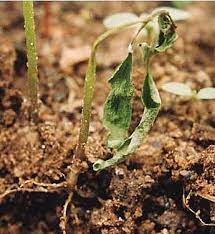
dampilg off disease symptoms:
In Chilli nursery, on young plants (2-5 leaves) in nursery, water soaked lesions on collar region is seen, chlorotic leaves. Later, the young plant wilts and dies.
dampilg off disease solution:
⮞ Neem Oil: Neem oil has antifungal properties and can be used as a preventive measure. Mix neem oil with water and spray the solution on the soil surface. Ensure you follow the recommended dilution ratios on the neem oil product.
⮞ Garlic Extract: Garlic has natural antifungal properties. Prepare a garlic extract by crushing garlic cloves and soaking them in water. Strain the solution and use it as a soil drench. The sulfur compounds in garlic can act as a deterrent to damping off pathogens.
⮞ Chamomile Tea: Chamomile tea has mild antifungal properties. Brew chamomile tea, let it cool, and use it as a soil drench. The tea can help suppress damping off fungi.
⮞ Avoid Overcrowding: Avoid overcrowding seedlings. Plant seeds at recommended distances to ensure good air circulation, reducing the chances of disease transmission.

Die-back and Anthracnose (fruit rot) Symptoms:
There is profuse shedding of flowers. The flower stalk shrivel and dry up. This drying up spreads from the flower stalks to the stem and subsequently causes die-back of the branches and stem and the branches wither. Partia1lly affected plants bear fruits which are few and of low quality
Die-back and Anthracnose (fruit rot) Solution:
⮞ Neem Oil: Neem oil is a natural pesticide with antifungal properties. It can be effective against anthracnose and die-back. Mix neem oil with water and apply it to the foliage regularly. Neem oil also acts as a repellent against pests that may spread diseases.
⮞ Baking Soda Solution: A solution of baking soda can help control fungal diseases. Mix 1-2 teaspoons of baking soda in a gallon of water and spray it on the chili plants. This can help prevent and manage anthracnose.
⮞ Garlic and Chili Pepper Spray: Create a natural pesticide by blending garlic and chili peppers with water. Strain the mixture and use it as a spray. Both garlic and chili peppers have antifungal and insect-repelling properties.
⮞ Milk Spray: Milk has been shown to have antifungal properties. Mix one part milk with nine parts water and spray it on the plants. This can help prevent and manage anthracnose.
⮞ 11. Vinegar Solution: A diluted solution of apple cider vinegar (1-2 tablespoons per gallon of water) can act as a natural fungicide. Spray it on the plants, especially after rainfall, to help prevent fungal infections.
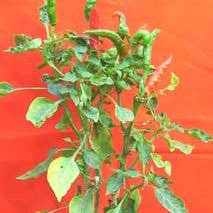
Mosaic complex. Symptom:
Young leaves develop a yellowish mosaic followed by diffused chlorosis and become distorted, elongated and stunted. Large yellowish ring spots and oak leaf markings develop on older leaves. Affected leaves frequently drop prematurely. On fruits, concentric rings and solid circular spots develop.
Mosaic complex Solution:
⮞ control Aphids and Whiteflies: Aphids and whiteflies are common vectors for mosaic viruses. Use natural methods to control these insects, such as:
Introduce natural predators like ladybugs and parasitic wasps.
Spray a mixture of neem oil and water on the plants.
Use insecticidal soap or garlic spray to deter aphids and whiteflies.
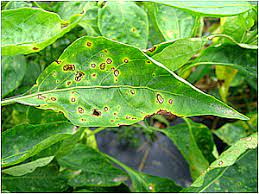
Powdery mildew symptom:
White powdery growth on lower side of leaves. The powdery mildew disease cycle (life cycle) starts when spores (known as conidia) land on a chilli leaf. Spores germinate much like a seed and begin to grow into the leaf. chilli powdery mildew parasitizes the plant using it as a food source
Powdery mildew Solution:
⮞ Neem Oil: Neem oil has antifungal properties and is effective against powdery mildew. Mix neem oil with water and a few drops of dish soap. Spray this solution on your chili plants, covering both sides of the leaves. Repeat every 7-14 days or as needed.
⮞ Baking Soda Spray: A mixture of baking soda and water can create an environment that is less favorable for powdery mildew. Mix 1 tablespoon of baking soda with 1 gallon of water and a few drops of dish soap. Spray the solution on your chili plants, paying attention to the undersides of leaves. Repeat every 7-14 days
⮞ Milk Spray: Milk contains compounds that can help control powdery mildew. Mix one part milk with two parts water and spray it on your chili plants. Repeat every 10-14 days.
⮞ Garlic Spray: Garlic has natural antifungal properties. Crush a few garlic cloves and steep them in water. Strain the liquid and dilute it with water. Spray the solution on your plants, focusing on the affected areas. Repeat regularly.
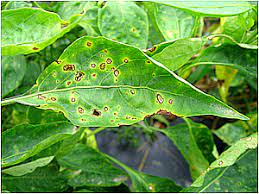
Bacterial leaf spot symptom:
Bacterial leaf spot, caused by Xanthomonas campestris pv. vesicatoria, is the most common and destructive disease for peppers in the eastern United States. It is a gram-negative, rod-shaped bacterium that can survive in seeds and plant debris from one season to another (Frank et al. 2005)
Bacterial leaf spot Solution:
⮞ Garlic Spray: Garlic has natural antibacterial and antifungal properties. Create a garlic spray by crushing garlic cloves and steeping them in water. Strain the liquid and dilute it with water. Spray this solution on your chili plants, focusing on the affected areas. Repeat regularly.
⮞ Aloe Vera: Aloe vera has natural antibacterial properties. You can extract the gel from aloe vera leaves and dilute it with water. Spray the solution on the plants, concentrating on the affected areas.
⮞ Baking Soda Solution: Baking soda can help create an environment less favorable for bacterial growth. Mix 1 tablespoon of baking soda with 1 gallon of water and a few drops of dish soap. Spray the solution on your plants, focusing on the infected areas. Repeat every 7-14 days.
⮞ Compost Tea: Compost tea can promote overall plant health and help prevent bacterial diseases. Brew compost tea and spray it on your plants. This provides beneficial microorganisms that can compete with harmful bacteria.
⮞ Vinegar Spray: White vinegar has antibacterial properties. Mix one part white vinegar with three parts water and spray it on your chili plants. Test the solution on a small area first to ensure it doesn't harm your plants.
⮞ Cultural Practices: Implement good gardening practices, such as proper spacing between plants, pruning for good air circulation, and rotating crops. These practices reduce the likelihood of bacterial diseases.
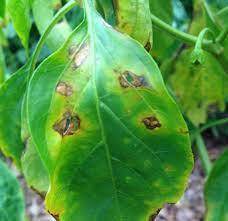
Alternaria leaf spot symptom:
This is a common disease of chilli occurring on the foliage at any stage of the growth. The fungus attacks the foliage causing characteristic leaf spots and blight. Early blight is first observed on the plants as small, black lesions mostly on the older foliage
Alternaria leaf spot Solution:
⮞ Neem Oil: Neem oil has antifungal properties and is effective against various fungal diseases. Mix neem oil with water and a few drops of dish soap. Spray this solution on your chili plants, covering both sides of the leaves. Repeat every 7-14 days or as needed.
⮞ Baking Soda Spray: Baking soda can help control fungal diseases, including alternate leaf spot. Mix 1 tablespoon of baking soda with 1 gallon of water and a few drops of dish soap. Spray the solution on your plants, paying attention to the undersides of leaves. Repeat every 7-14 days.
⮞ Garlic Spray: Garlic has natural antifungal properties. Crush a few garlic cloves and steep them in water. Strain the liquid and dilute it with water. Spray the solution on your plants, focusing on the affected areas. Repeat regularly.
⮞ Milk Spray: Milk contains compounds that can help control fungal diseases. Mix one part milk with two parts water and spray it on your chili plants. Repeat every 10-14 days.
⮞ Cinnamon Powder: Cinnamon has antifungal properties. Sprinkle cinnamon powder on the soil surface around your chili plants and on the lower leaves. This can help prevent the spread of fungal spores.
⮞ Cultural Practices: Implement good gardening practices, such as proper spacing between plants, rotating crops, and removing and destroying infected plant material. These practices reduce the likelihood of fungal diseases.